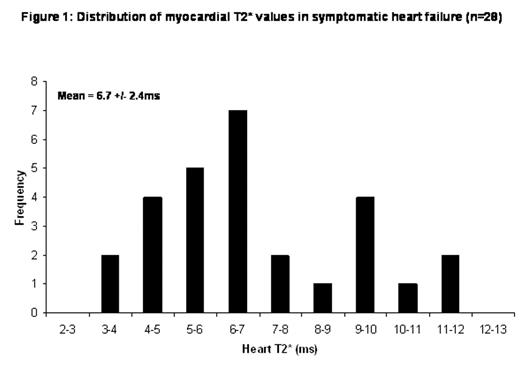Abstract
Introduction: Myocardial iron overload is a well established cause of heart failure in a number of haematological disorders and is the leading cause of death in β-thalassaemia major (TM). Once overt heart failure develops prognosis is very poor and it would therefore be desirable to identify patients at risk, prior to the development of symptomatic heart failure. Myocardial iron can now be rapidly and reproducibly assessed using a validated cardiac magnetic resonance (CMR) T2* technique. Left ventricular ejection fraction has been demonstrated to relate to myocardial T2* (normal >20ms), and accordingly iron overloaded patients with symptomatic heart failure are likely to have a low T2* but there are no reports of the myocardial T2* level in newly presenting patients with heart failure and the threshold for increased risk is also unknown.
Purpose: To establish the distribution of myocardial T2* values in patients presenting with symptomatic heart failure secondary to iron overload.
Methods: Database records of CMR T2* assessments over a 5 year period were reviewed to identify iron overloaded patients presenting with heart failure.
Results: 28 patients (median age 29y, 11–79) with iron overload and documented heart failure were identified. 22 patients had thalassaemia major, 3 hereditary haemochromatosis, and 3 had miscellaneous transfusion dependent anaemias. The mean myocardial T2* in all groups was 6.8+/− 2.2ms reflecting severe iron loading by clinical criteria. See figure 1. Myocardial T2* values were similar between sub-groups as follows: TM patients 6.7+/− 2.4ms, haemochromatosis 7.7ms (6.7–7.4ms), miscellaneous 6.8ms (4.8–9.1ms).
Conclusion: In this database review, the patients developing heart failure secondary to iron overload all had abnormal myocardial T2*, and overall 89% of heart failure patients had values less than 10ms, which reflects severe myocardial iron loading. This data suggests a myocardial T2* <10ms should be considered a threshold for risk of heart failure (with its attendant high mortality) and such patients should be treated aggressively with increased iron chelation. It also suggests that clinical heart failure occurs nearly exclusively in patients with severe myocardial iron loading.
Distribution of myocardial T2+ values in symptomatic heart failure (n=28)
Distribution of myocardial T2+ values in symptomatic heart failure (n=28)
Author notes
Corresponding author


This feature is available to Subscribers Only
Sign In or Create an Account Close Modal